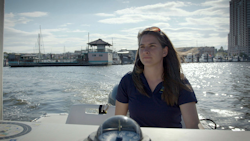SEJournal Online is the digital news magazine of the Society of Environmental Journalists. Learn more about SEJournal Online, including submission, subscription and advertising information.
 |
 |
| The Back River wastewater treatment plant in Dundalk, Maryland, above, was one of two that was forced to clean up discharges that had dumped millions of gallons of poorly treated wastewater into the Chesapeake Bay. Photo: Duy Linh Tu and Sebastian Tuinder. |
FEJ StoryLog: Grant Brings Documentary Team to Chesapeake Bay’s Vastness
By Sebastian A. Tuinder
October 2022 marked the 50th anniversary of the U.S. Clean Water Act — a decent news hook for any story about a compromised body of water. So began my research for a multimedia documentary into the conditions of the country’s waterways and the subsequent rabbit holes involving the decades old federal and state policies.
I grew up in South Africa, and sure, I am biased, but it is arguably one of the most beautiful and biodiverse natural environments in the world. I spent weekends fishing at lakes and rivers, and vacations camping at the coast. My family and I loved the water — we still do. Which is why my research into U.S. waterways was so unsettling.
It was difficult to find a U.S. body of
water not struggling with anthropogenic
issues. But it was the Chesapeake Bay
that really grabbed my attention.
It was difficult to find a U.S. body of water not struggling with anthropogenic issues such as pollution, sea level rise, erosion, increasing temperatures, overfishing, overharvesting, overdevelopment, drought, floods, … the list goes on. But it was the Chesapeake Bay that really grabbed my attention.
A staggering 64,000-square-mile watershed
At a whopping 4,500 square miles, the Chesapeake Bay is the largest estuary in the country. Its watershed is a staggering 64,000 square miles. Its largest source of fresh water comes from the Susquehanna River, which begins all the way north in Cooperstown, New York.
The bay is home to 10 million people and produces $33 billion annually in economic income from shipping, tourism and seafood businesses. It is home to 3,600 species of marine life, including the prized blue crab and the bay’s favorite sportfish, the Atlantic striped bass, known locally as rockfish.
I learned scientists and local fishermen are concerned about a steep decline in the blue crab population, especially the drop in juvenile crabs.
In 2022, an annual winter dredge survey found the bay’s overall blue crab population had dropped to 227 million from nearly 600 million in 2019. The juvenile blue crab population sunk from 324 million in 2019 to 101 million in 2022.
Declining blue crab, rockfish populations
After talking to scientists, researchers, local residents and local fishermen, I found fingers pointing in a dozen different directions as to why they believe the blue crab population is “tanking:” industrial pollution, agricultural runoff, climate change, over-harvesting and invasive species. A handful of climate change deniers say, “It’s just a cycle.”
Well, actually, that is not far off. The life cycle of blue crabs is approximately three years. A small juvenile population two years in a row can be counteracted by a large one the following year. So, the life cycle of the crabs may be a factor.
While the steep decline from 2019 to 2022 is alarming, scientifically speaking, a population’s decline is only a hypothesis until low numbers of juveniles are recurring for a period long enough to deplete its existing population. Still, there are many other signs the bay’s overall health is in trouble.
Fishermen I interviewed confirmed also seeing a decline in Atlantic striped bass. Annapolis fishing legend Tom Weaver offered to take us out on his boat to show us what was going on, rather than try to tell us over Zoom, phone calls, emails and texts. We had to get to Annapolis.
A grant from the Society of Environmental Journalists’ Fund for Environmental Journalism made the production trip to the Chesapeake Bay happen.
“You’re going to love it, Seb,” my mentor Duy Linh Tu said. “You’ll never want to go back to Brooklyn.” Duy was not wrong. It is truly a beautiful part of the world. And no matter where you stand on the shore or where you are on the water, it is impossible to truly grasp the sheer size of the bay.
Evidence of the Chesapeake’s troubles
Our production trip went on without a hitch. We met with Weaver, who took us out on the water, showing us how the changes in the bay he has seen over the last few years are impacting his 30-year-old charter boat fishing business. He makes money by bringing people to the fish. And with fish moving or being forced out by poor water quality, his job is more difficult and expensive.
 |
| Bluewater Baltimore scientist Alice Volpitta in her monitoring boat. Photo: Duy Linh Tu and Sebastian Tuinder. |
This production trip also enabled us to visit two nonprofits involved in bay conservation and water quality monitoring. And, yes, more boats, more time on the water and many more moments feeling how lucky we were to be producing this story. The researchers and scientists we met confirmed the troubles the Chesapeake faces and offered further insight into its degradation.
Alice Volpitta, the Baltimore harbor keeper and scientist at the environmental nonprofit Bluewater Baltimore, pointed to discharges from Maryland’s two largest wastewater treatment plants. Years of mismanagement meant millions of gallons of poorly treated wastewater was being dumped into the bay. High levels of nutrients (nitrogen and phosphorus) were causing algal blooms. As the algae die, it starves the water of oxygen, creating inhabitable portions of the bay for marine life.
Project helped drive local push for accountability
In May 2023, Scientific American and Baltimore Brew co-published “Trouble in the Chesapeake,” the documentary Duy and I co-produced with partial funding from the Pulitzer Center, the Society of Environmental Journalists and the Institute for Journalism & Natural Resources.
Thanks to the efforts of Bluewater Baltimore, local nonprofits, environmental legal teams and, in part, our documentary, the city of Baltimore was held accountable for the malfunctioning treatment plants. The state of Maryland took control of both the Patapsco and Back River treatment plants and brought the wastewater discharges to within U.S. Environmental Protection Agency requirements.
“Trouble in the Chesapeake” was nominated for a Capitol Emmy and was the subject of the Smith/Patterson Lecture at the University of Missouri.
Our relationship with sources and other participants of this documentary also yielded many more story ideas and the promise of further coverage of the bay. We hope to develop these ideas and produce many more stories about the Chesapeake Bay in the future.
[Editor’s Note: Read more on covering watersheds and understanding how estuaries underpin the environment’s health, plus visit our “Topic on the Beat: Water & Oceans” page.]
 |
Sebastian A. Tuinder is a freelance journalist and documentary filmmaker based in Brooklyn, New York. His work focuses on science and the natural environment and can be found in Scientific American, Grist, Undark, Gothamist, Al Jazeera, Baltimore Brew and BBC. He teaches video storytelling at Columbia University School of Journalism and audio storytelling at Brooklyn College.
 |
Duy Linh Tu is a journalist and documentary filmmaker, focusing on science, climate and the environment. His work has appeared in print, online, on television and in theaters. He is also the author of “Narrative Storytelling for Multimedia Journalists.” He is Columbia University’s School of Journalism’s Dean of Academic Affairs and teaches reporting and video storytelling courses.
* From the weekly news magazine SEJournal Online, Vol. 9, No. 32. Content from each new issue of SEJournal Online is available to the public via the SEJournal Online main page. Subscribe to the e-newsletter here. And see past issues of the SEJournal archived here.












 Advertisement
Advertisement 



